+ Open data
Open data
- Basic information
Basic information
| Entry | Database: PDB / ID: 4pri | ||||||
|---|---|---|---|---|---|---|---|
| Title | Crystal structure of TK3 TCR-HLA-B*35:08-HPVG complex | ||||||
 Components Components |
| ||||||
 Keywords Keywords | IMMUNE SYSTEM / human leukocyte antigen class I / Epstein-Barr virus / viral escape / T cell receptor / viral immunity | ||||||
| Function / homology |  Function and homology information Function and homology informationhost cell PML body / viral latency / alpha-beta T cell receptor complex / Hydrolases; Acting on ester bonds; Endodeoxyribonucleases producing 5'-phosphomonoesters / symbiont-mediated disruption of host cell PML body / Translocation of ZAP-70 to Immunological synapse / Phosphorylation of CD3 and TCR zeta chains / regulation of DNA replication / alpha-beta T cell activation / Generation of second messenger molecules ...host cell PML body / viral latency / alpha-beta T cell receptor complex / Hydrolases; Acting on ester bonds; Endodeoxyribonucleases producing 5'-phosphomonoesters / symbiont-mediated disruption of host cell PML body / Translocation of ZAP-70 to Immunological synapse / Phosphorylation of CD3 and TCR zeta chains / regulation of DNA replication / alpha-beta T cell activation / Generation of second messenger molecules / Co-inhibition by PD-1 / antigen processing and presentation of peptide antigen via MHC class I / enzyme-substrate adaptor activity / negative regulation of receptor binding / early endosome lumen / Nef mediated downregulation of MHC class I complex cell surface expression / DAP12 interactions / transferrin transport / cellular response to iron ion / Endosomal/Vacuolar pathway / Antigen Presentation: Folding, assembly and peptide loading of class I MHC / response to bacterium / peptide antigen assembly with MHC class II protein complex / lumenal side of endoplasmic reticulum membrane / cellular response to iron(III) ion / negative regulation of forebrain neuron differentiation / MHC class II protein complex / antigen processing and presentation of exogenous protein antigen via MHC class Ib, TAP-dependent / ER to Golgi transport vesicle membrane / peptide antigen assembly with MHC class I protein complex / regulation of iron ion transport / regulation of erythrocyte differentiation / HFE-transferrin receptor complex / response to molecule of bacterial origin / MHC class I peptide loading complex / T cell mediated cytotoxicity / positive regulation of T cell cytokine production / antigen processing and presentation of endogenous peptide antigen via MHC class I / antigen processing and presentation of exogenous peptide antigen via MHC class II / positive regulation of immune response / MHC class I protein complex / peptide antigen binding / positive regulation of T cell activation / negative regulation of neurogenesis / positive regulation of receptor-mediated endocytosis / cellular response to nicotine / positive regulation of T cell mediated cytotoxicity / multicellular organismal-level iron ion homeostasis / specific granule lumen / phagocytic vesicle membrane / recycling endosome membrane / Interferon gamma signaling / Immunoregulatory interactions between a Lymphoid and a non-Lymphoid cell / negative regulation of epithelial cell proliferation / MHC class II protein complex binding / Modulation by Mtb of host immune system / late endosome membrane / sensory perception of smell / positive regulation of cellular senescence / tertiary granule lumen / DAP12 signaling / Downstream TCR signaling / T cell differentiation in thymus / T cell receptor signaling pathway / negative regulation of neuron projection development / ER-Phagosome pathway / protein refolding / early endosome membrane / endonuclease activity / protein homotetramerization / amyloid fibril formation / symbiont-mediated suppression of host NF-kappaB cascade / adaptive immune response / intracellular iron ion homeostasis / learning or memory / immune response / endoplasmic reticulum lumen / DNA-binding transcription factor activity / Amyloid fiber formation / Golgi membrane / lysosomal membrane / external side of plasma membrane / focal adhesion / Neutrophil degranulation / positive regulation of DNA-templated transcription / SARS-CoV-2 activates/modulates innate and adaptive immune responses / structural molecule activity / cell surface / endoplasmic reticulum / Golgi apparatus / protein homodimerization activity / extracellular space / DNA binding / extracellular exosome / extracellular region / identical protein binding / membrane / plasma membrane / cytosol Similarity search - Function | ||||||
| Biological species |  Homo sapiens (human) Homo sapiens (human) Human herpesvirus 4 (Epstein-Barr virus) Human herpesvirus 4 (Epstein-Barr virus) | ||||||
| Method |  X-RAY DIFFRACTION / X-RAY DIFFRACTION /  SYNCHROTRON / SYNCHROTRON /  MOLECULAR REPLACEMENT / MOLECULAR REPLACEMENT /  molecular replacement / Resolution: 2.4 Å molecular replacement / Resolution: 2.4 Å | ||||||
 Authors Authors | Yu Chih, L. / Rossjohn, J. / Gras, S. | ||||||
 Citation Citation |  Journal: J.Biol.Chem. / Year: 2014 Journal: J.Biol.Chem. / Year: 2014Title: A Molecular Basis for the Interplay between T Cells, Viral Mutants, and Human Leukocyte Antigen Micropolymorphism. Authors: Liu, Y.C. / Chen, Z. / Neller, M.A. / Miles, J.J. / Purcell, A.W. / McCluskey, J. / Burrows, S.R. / Rossjohn, J. / Gras, S. | ||||||
| History |
|
- Structure visualization
Structure visualization
| Structure viewer | Molecule:  Molmil Molmil Jmol/JSmol Jmol/JSmol |
|---|
- Downloads & links
Downloads & links
- Download
Download
| PDBx/mmCIF format |  4pri.cif.gz 4pri.cif.gz | 181.8 KB | Display |  PDBx/mmCIF format PDBx/mmCIF format |
|---|---|---|---|---|
| PDB format |  pdb4pri.ent.gz pdb4pri.ent.gz | 142.1 KB | Display |  PDB format PDB format |
| PDBx/mmJSON format |  4pri.json.gz 4pri.json.gz | Tree view |  PDBx/mmJSON format PDBx/mmJSON format | |
| Others |  Other downloads Other downloads |
-Validation report
| Summary document |  4pri_validation.pdf.gz 4pri_validation.pdf.gz | 461.4 KB | Display |  wwPDB validaton report wwPDB validaton report |
|---|---|---|---|---|
| Full document |  4pri_full_validation.pdf.gz 4pri_full_validation.pdf.gz | 476.4 KB | Display | |
| Data in XML |  4pri_validation.xml.gz 4pri_validation.xml.gz | 30.8 KB | Display | |
| Data in CIF |  4pri_validation.cif.gz 4pri_validation.cif.gz | 42.6 KB | Display | |
| Arichive directory |  https://data.pdbj.org/pub/pdb/validation_reports/pr/4pri https://data.pdbj.org/pub/pdb/validation_reports/pr/4pri ftp://data.pdbj.org/pub/pdb/validation_reports/pr/4pri ftp://data.pdbj.org/pub/pdb/validation_reports/pr/4pri | HTTPS FTP |
-Related structure data
| Related structure data |  4pr5C  4praC  4prbC  4prdC  4preC  4prhC  4prnC 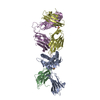 4prpC 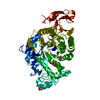 3vm7S C: citing same article ( S: Starting model for refinement |
|---|---|
| Similar structure data |
- Links
Links
- Assembly
Assembly
| Deposited unit | 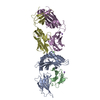
| ||||||||
|---|---|---|---|---|---|---|---|---|---|
| 1 |
| ||||||||
| Unit cell |
| ||||||||
| Details | biological unit is the same as asym. |
- Components
Components
-Protein , 4 types, 4 molecules ABDE
| #1: Protein | Mass: 31984.281 Da / Num. of mol.: 1 Source method: isolated from a genetically manipulated source Source: (gene. exp.)  Homo sapiens (human) / Gene: HLA-B, HLAB / Plasmid: pET30 / Production host: Homo sapiens (human) / Gene: HLA-B, HLAB / Plasmid: pET30 / Production host:  |
|---|---|
| #2: Protein | Mass: 11748.160 Da / Num. of mol.: 1 Source method: isolated from a genetically manipulated source Source: (gene. exp.)  Homo sapiens (human) / Gene: B2M, CDABP0092, HDCMA22P / Plasmid: pET30 / Production host: Homo sapiens (human) / Gene: B2M, CDABP0092, HDCMA22P / Plasmid: pET30 / Production host:  |
| #4: Protein | Mass: 22429.695 Da / Num. of mol.: 1 Source method: isolated from a genetically manipulated source Source: (gene. exp.)  Homo sapiens (human) / Plasmid: pET30 / Production host: Homo sapiens (human) / Plasmid: pET30 / Production host:  |
| #5: Protein | Mass: 27066.000 Da / Num. of mol.: 1 Source method: isolated from a genetically manipulated source Source: (gene. exp.)  Homo sapiens (human) / Plasmid: pET30 / Production host: Homo sapiens (human) / Plasmid: pET30 / Production host:  |
-Protein/peptide , 1 types, 1 molecules C
| #3: Protein/peptide | Mass: 1327.374 Da / Num. of mol.: 1 / Source method: obtained synthetically / Source: (synth.)  Human herpesvirus 4 (Epstein-Barr virus) / References: UniProt: P03211 Human herpesvirus 4 (Epstein-Barr virus) / References: UniProt: P03211 |
|---|
-Non-polymers , 3 types, 60 molecules 




| #6: Chemical | | #7: Chemical | #8: Water | ChemComp-HOH / | |
|---|
-Details
| Has protein modification | Y |
|---|
-Experimental details
-Experiment
| Experiment | Method:  X-RAY DIFFRACTION / Number of used crystals: 1 X-RAY DIFFRACTION / Number of used crystals: 1 |
|---|
- Sample preparation
Sample preparation
| Crystal | Density Matthews: 2.74 Å3/Da / Density % sol: 55.07 % |
|---|---|
| Crystal grow | Temperature: 298 K / Method: vapor diffusion / pH: 5.6 Details: 18% PEG 3350, 0.2M LiSO4 and 0.1M Na-Citrate pH 5.6, vapor diffusion, temperature 298K |
-Data collection
| Diffraction | Mean temperature: 100 K | |||||||||||||||||||||||||||||||||||||||||||||||||||||||||||||||||||||||||||||||||||||||||||
|---|---|---|---|---|---|---|---|---|---|---|---|---|---|---|---|---|---|---|---|---|---|---|---|---|---|---|---|---|---|---|---|---|---|---|---|---|---|---|---|---|---|---|---|---|---|---|---|---|---|---|---|---|---|---|---|---|---|---|---|---|---|---|---|---|---|---|---|---|---|---|---|---|---|---|---|---|---|---|---|---|---|---|---|---|---|---|---|---|---|---|---|---|
| Diffraction source | Source:  SYNCHROTRON / Site: SYNCHROTRON / Site:  Australian Synchrotron Australian Synchrotron  / Beamline: MX1 / Wavelength: 0.984 Å / Beamline: MX1 / Wavelength: 0.984 Å | |||||||||||||||||||||||||||||||||||||||||||||||||||||||||||||||||||||||||||||||||||||||||||
| Detector | Type: ADSC QUANTUM 315r / Detector: CCD / Date: Feb 15, 2009 | |||||||||||||||||||||||||||||||||||||||||||||||||||||||||||||||||||||||||||||||||||||||||||
| Radiation | Protocol: SINGLE WAVELENGTH / Monochromatic (M) / Laue (L): M / Scattering type: x-ray | |||||||||||||||||||||||||||||||||||||||||||||||||||||||||||||||||||||||||||||||||||||||||||
| Radiation wavelength | Wavelength: 0.984 Å / Relative weight: 1 | |||||||||||||||||||||||||||||||||||||||||||||||||||||||||||||||||||||||||||||||||||||||||||
| Reflection | Resolution: 2.4→41.7 Å / Num. all: 73467 / Num. obs: 73467 / % possible obs: 93.6 % / Observed criterion σ(F): 0 / Observed criterion σ(I): -3 / Biso Wilson estimate: 33.018 Å2 / Rmerge(I) obs: 0.07 / Χ2: 0.944 / Net I/σ(I): 10.77 | |||||||||||||||||||||||||||||||||||||||||||||||||||||||||||||||||||||||||||||||||||||||||||
| Reflection shell | Diffraction-ID: 1
|
-Phasing
| Phasing | Method:  molecular replacement molecular replacement |
|---|
- Processing
Processing
| Software |
| ||||||||||||||||||||||||
|---|---|---|---|---|---|---|---|---|---|---|---|---|---|---|---|---|---|---|---|---|---|---|---|---|---|
| Refinement | Method to determine structure:  MOLECULAR REPLACEMENT MOLECULAR REPLACEMENTStarting model: pdb entry 3VM7 Resolution: 2.4→41.7 Å / σ(F): 0 / Stereochemistry target values: ML
| ||||||||||||||||||||||||
| Displacement parameters | Biso max: 136.27 Å2 / Biso mean: 34.1721 Å2 / Biso min: 3.68 Å2 | ||||||||||||||||||||||||
| Refinement step | Cycle: LAST / Resolution: 2.4→41.7 Å
|
 Movie
Movie Controller
Controller



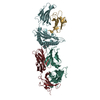

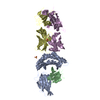
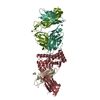
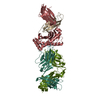
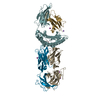
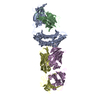
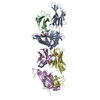
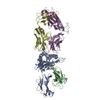
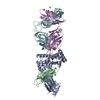
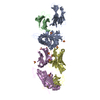
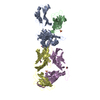
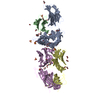
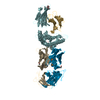
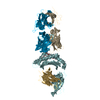
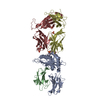
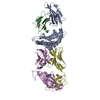


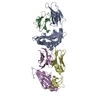
 PDBj
PDBj








